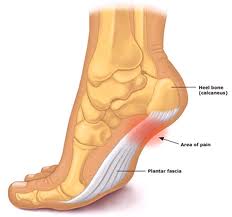 As we discussed in a previous blog post, plantar fasciitis is the most common foot pain complaint. Several factors can lead to the development of plantar fasciitis: age, gender, certain types of exercises, excess weight, overuse of the plantar fascia, incorrect foot mechanics, and wearing improperly fitted shoes. So what if you’re one of the millions of Americans who suffer from plantar fasciitis? How can you get pain relief?
As we discussed in a previous blog post, plantar fasciitis is the most common foot pain complaint. Several factors can lead to the development of plantar fasciitis: age, gender, certain types of exercises, excess weight, overuse of the plantar fascia, incorrect foot mechanics, and wearing improperly fitted shoes. So what if you’re one of the millions of Americans who suffer from plantar fasciitis? How can you get pain relief?
About 90% of people who have plantar fasciitis recover with home-care treatments in a few months. By following these recommendations for dealing with your case of plantar fasciitis, you can be on your way to having pain-free feet.
Seek Treatment at On-Set
Don’t wait to treat plantar fasciitis. An inflamed fascia when left untreated will be harder to heal in the long run.
Rest
Resting your inflamed foot usually helps to eliminate the most severe pain. You should avoid the activity that caused the pain in the first place, such as not jogging for a few days or sitting instead of prolonged standing/walking.
Apply Ice Packs
Ice reduces the inflammation. You should apply the ice for 10 minutes on your foot and for 20 minutes off, for as often as possible.
Medication
An anti-inflammatory drug, like Tylenol® or Aleve®, can work wonders by easing the pain and inflammation.
Stretching and Strengthening Exercises
Stretches and exercises can help relax the tissues surrounding the heel bone and strengthen any weaknesses in the foot muscles. By performing stretches and exercises in the morning and evening, you should begin to feel better quickly.
Night Splint
You should buy and use a night splint, which an apparatus you wear on your foot while you sleep in order to hold it in a proper position for healing. A night splint is probably one of the best things you can do to speed up the healing process. Normally during sleep, your foot goes into a relaxed position, and the fascia is shortened. But a night splint will hold your foot in a right angle during sleep, elongating the fascia. Proper healing can then take place.
Custom Orthotics
Custom orthotics are often the key to successful treatment of plantar fasciitis. However, all custom orthotics are not created equal. Some orthotics, called accommodated custom orthotics, are designed to stop or limit the motion of the foot. They’re only recommended for people who are less active, have rigid motionless feet in the first place, and may be used to heal an inflamed fascia. However, it should not be used after the fascia is healed. Long-term use of an accommodated custom orthotic will limit proper biomechanical motion. Motion is health, and the lack of it is not. Therefore, you should buy and use a proper biomechanically designed custom orthotic, like the ezWalker® Performance Insole. Your feet will feel better faster and stay healthier longer.
Properly Fitted Shoes
You should make sure that your shoes fit properly. The WalkEzStore provides information on how to properly fit your shoes to your feet. Since shoes sizes can vary depending upon the manufacturer, you shouldn’t worry about the size listed on the box. It’s more important to learn where your foot should sit inside a shoe. Improperly fitted footwear is one of the biggest reasons plantar fasciitis is such a widespread problem.
These recommendations have been proven to speed healing of plantar fasciitis; however, if your pain persists or worsens, you should visit your doctor for a more complete diagnosis and treatment since you may have a more serious condition.
For more information on the ezWalker® Performance Insoles, visit our website. The ezWalker® is ultra thin and ¾ in length, so it can transfer easily from shoe to shoe. Plus, it can be worn with almost any type of footwear. So order your ezWalker® Performance Insoles today! You’ve got nothing to lose but your plantar fasciitis foot pain.
Remember … when your feet feel good, you feel good.

